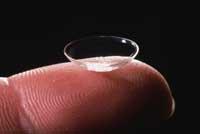Contact lenses between comfort, aesthetics and irritation

A woman of the Japanese aristocracy had the habit of writing lists of things and keeping them under the bed. Wishlist, list of doors, list of games, list of places… you can write endless lists.
If we associate this game with today's theme, it is not difficult to form a fairly long list: hard, soft, disposable, cosmetic lenses, which solve more than one visual problem, of all kinds, but some produce irritation to red and red, leaving the lenses and preferring to wear glasses.
This irritation is based on the respiratory difficulty of the eye and the microorganisms that accumulate in the lenses. Therefore, it is necessary to clean the contact lenses well every night or, at best, at least once a week. The goal of experts in the design of new contact lenses is to move this annoying task into history.
More comfortable contact lenses

Comfort, flexibility and aesthetics have been the objectives that have guided the evolution of the lenses since the eye was repaired, which began with Leonardo da Vinci. At present, the priority of research is to reduce eye irritation caused by lenses.
Irritation is due to the accumulation of bacteria and other microorganisms around the lenses during the day. That is why every day you have to clean the lenses, even though more than one is confused with this task. Those looking for comfort, for the moment, will find in the market the monthly lenses and those that serve for a single day, but it is possible that soon there are lenses that can be used without removing them or cleaning them throughout the year.
In this sense, two years ago a group of North American chemicals created a new polymer material for the manufacture of contact lenses. The main property of this material is its absorption capacity. The more water absorbed, the softer it is made, so it is ideal for eye contact lenses.
Until now, materials with water absorption capacity also attracted proteins and caused infections in the eyes that damaged the view. To avoid this phenomenon, the researchers used sulphoxides instead of ions. Sulphoxides, due to their high polarity, attract water, but unlike ions, do not attract charged proteins.

As has already been commented, the new material was developed two years ago, but it seems that it is not as successful a material as could be expected and the research teams have not rested.
Latest investigations
Recently, a team of researchers from the University of Texas has announced the upcoming staging in the lens market that can be used day and night without a year of cleaning.
The key to the contact lenses being designed is a thin protective layer of selenium that keeps the lenses clean of bacteria. Selenium is a natural and antioxidant component found in the soil, some plants and many of the foods we consume. It is used a lot in our immune system, since it has the ability to kill bacteria.
On the other hand, this layer has a thickness of a single molecule, so it does not affect at all the ability to yield the oxygen passage of the lens, that is, it does not prevent the breath of the eye. In addition, there is no drawback in that due to a technical problem selenium of the lens is revealed. Because only 0.01% of the selenium we consume in the lens. The only thing the user has to do is to have the immersed lens from time to time in the selenium solution so that the layer is reformed.

For the moment, the researchers assure that the results of the tests carried out with the rabbits are encouraging. Rabbits have not been removed from new lenses for two months and it has been observed that they have no irritation whatsoever. Thus, scientists have advanced that these lenses can be used without removing them to clean them for two years. But there is still much to do and it seems that we will have to wait another two years to find those lenses in the market. But other scientists who work with lenses do not see progress so clear. They say that in addition to bacteria, the pollution of the medium must be taken into account. Strange particles that are not bacteria accumulate daily in the lenses and their cleansing is fundamental to keep the eyes healthy. In addition, there are many other reasons not to use the same lenses for more than 30 days.
Therefore, this invention may not serve all people. The inventor of the new lenses has also recognized that there are still many trials to be done, although all the results obtained so far have been very good.
Published in 7K.
Buletina
Bidali zure helbide elektronikoa eta jaso asteroko buletina zure sarrera-ontzian











